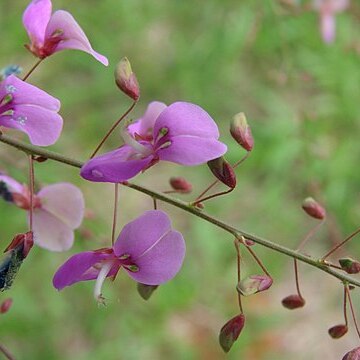Herbs, subshrubs, or shrubs, prostrate or scrambling to erect. Leaves 1-3 (or rarely-5)-foliolate, petiolate, stipulate; leaflets petiolulate and stipellate. In-florescences axillary or terminal, racemose or racemose paniculate, or extremely dense and capitate; primary bracts striate and ciliate, each subtending 1 (pedi-cellate) flower, or a fascicle of 2 to several flowers; secondary bracts often pres-ent, similar to the primary bracts or depauperate, each subtending a single flower; bracteoles rarely if ever present in American species. Flowers pedicellate, pap-ilionaceous, calyx 2-lobed, the upper lobe almost entire to bifid, the lower 3-toothed with the central tooth longer than the laterals, or the calyx almost equally 5-lobed; corolla exceeding the calyx, the standard slightly clawed, wings some-what so, wings often attached to keel petals by a small appendage, keel petals long clawed, partially fused above; vexillary stamen free or partially fused; an-thers uniform; ovary sessile or stipitate, ovules 2-many, the style slender, the stigma terminal. Fruit lomentaceous, i.e., transversely septate and forming (1-)2-many articles, usually stipitate, indehiscent, or tardily dehiscent, or in 1 species in Panama the walls between the sutures falling away leaving the sutures as a frame; articles variously shaped from nearly linear to almost saccate or circular and notched at the apex, sometimes folded on each other in accordion fashion (at least when young), the surfaces glabrous to densely pubescent with straight tapering or hooked trichomes, or these only on sutures, the articles 1-seeded. Seeds oblong or subquadrate to reniform.
Herbs, subshrubs, or shrubs. Leaves pinnately 3-foliolate or 1-foliolate by reduction of lateral leaflets, stipulate, stipellate. Flowers usually smaller, in racemes or panicles, axillary or terminal, rarely solitary or binate in leaf axils. Bracts persistent or early deciduous; bracteoles present or absent. Calyx campanulate, 4-or 5-lobed, bilabiate; upper 2 lobes connate for all or most of length, entire or 2-toothed at apex, lower lobes free, longest. Corolla white, green-white, pink, purple, or violet; standard elliptic or obovate to nearly orbicular; wings ± adherent to keel, wholly clawed. Stamens diadelphous (9+1), rarely monadelphous. Ovary usually sessile, with several to many ovules. Legume compressed, usually indehiscent, transversely segmented, upper (adaxial) suture slightly constricted or straight, lower (abaxial) one constricted; articles mostly ellipsoidal to quadrangular. Cotyledons epigeous.
Cal ± bilabiate, the upper 2 lobes connate for all or most of their length, the lower 3 separate; standard oblong to suborbicular, narrowed at base; wings oblong; keel nearly straight; stamens 10, usually diadelphous; fr indehiscent, stipitate, transversely segmented and eventually separating into 1-seeded joints (articles), ± beset with hooked hairs; ours all perennial herbs with ± petioled (rarely subsessile), pinnately 3-foliolate lvs and purple or pink or less often white fls in elongate racemes or panicles. (Meibomia.) 300, mainly warm reg.
Fruits usually stipitate or sometimes sessile, well-exserted from the calyx, compressed, (1)2–many-jointed into articles (loments), indehiscent or at length splitting up, the articles 1-seeded, membranous or leathery, almost flat or more rarely inflated; or in a few cases fruits dehiscing and not or scarcely breaking into articles.
Inflorescences axillary or terminal, falsely racemose or paniculate rarely subumbellate, the flowers solitary or fasciculate on the rhachis; primary bracts striate, persistent or sometimes membranous and early deciduous; secondary bracts often present but bracteoles usually absent.
Corolla mostly small, yellow or red; standard oblong to round or transverse, narrowed into a short claw, sometimes with small callous appendages; wings ± attached to the keel; keel petals clawed, partly joined.
Calyx 5-lobed, the lobes mostly ± 2-lipped or subequal; the upper lip entire or bidentate composed of 2 lobes joined together, the lower of 3 larger lobes, the central one the longest.
Leaves 1-foliolate or pinnately 3–5-foliolate; leaflets often large; stipules free, somewhat joined, or joined and leaf-opposed, striate; stipels present.
Ovary sessile, (1)2–many-ovuled; style inflexed or incurved, glabrous; stigma terminal, capitate or minute.
Stamens mostly diadelphous, the vexillary filament free or partly joined; anthers uniform.
Seeds oblong, reniform or subquadrangular, compressed; aril not developed.
Shrubs or erect or prostrate subshrubs or herbs.

